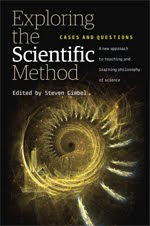Thermodynamics, Complementarity, and the Dangers of Gay Sex
A few more questions relating to physics, well, sorta.
Barefoot Bum asks,
What are "temperature" and "pressure"?An interesting question on a host of levels. To be a smart ass, I could pull the philosopher of language move and say that while temperature is a physical property, "temperature" is an 11 letter word starting with the letter t. It comes from the verb "to temper," that is, to mix, and was classically considered to be a result of the relative proportions of the four alchemical elements, the hot, the cold, the dry, and the moist, or in humans, of the vital humours. But I'll take it that BB is asking in a straightforward manner (not often a good bet with Barefoot).
In the modern vernacular, temperature and pressure are two of the state variables for thermodynamics. If you want a complete account of a thermodynamic system, you need to be able to specify its temperature and pressure. But what are they?
It is an interesting and tricky question to say what we mean by physical quantities. On one extreme, you find people like Percy Bridgeman, the Nobel Laureate who espoused a view we call operationalism, in which all a physical quantity means is that it is the outcome of a measurement operation. On this view, temperature is nothing more than the reading you get from a thermometer. Bridgeman was at Harvard at the same time as B. F. Skinner and you can see the same sort of refusal to go beyond the observable in Bridgeman's view as you see in Skinner's behaviorism.
There is good reason to move beyond this operational understanding, though. With the creation of atomic theory, the thought of physicists and physical chemists was that perhaps these macroscopic observable properties are really just manifestations of goings on at the microscopic level, goings on that we could describe in terms of other forces, preferably mechanical forces (things bumping into other things). This would afford a beautiful opportunity for simplifying our worldview, something physicists love to do. It is more elegant if we can describe the happenings in the world with the fewest number of concepts, so it is always a good thing to try to understand one set of concepts in terms of another.
In this way, James Clerk Maxwell proposed the kinetic theory of gasses in three famous papers in 1860, 1867, and 1879. It brought out in a comprehensive fashion something that was being developed by other important thinkers -- Daniel Bernoulli, Fourier, Helmholtz -- that thermodynamic quantities were really the result of molecules bouncing around. On this view, heat was not a separate thing as was previously thought, but just a measure of kinetic energy, the energy of motion of the molecules in the substance. In his first paper, Maxwell pictured gasses as a bunch of little billiard balls -- perfectly round, perfectly hard, and interacting only by contact -- that were all moving and bouncing off of each other and whatever container was holding the gas. Temperature would be a measure related to the average speed of the molecules and pressure would be a measure of the force that the molecules applied to the container when they bounce off of it.
The nice thing about reducing thermodynamics to mechanics is that we understand mechanics and it was governed by Newton's laws which give us complete predictability. At least for systems with two or fewer bodies interacting. Three or more objects and the equations are not exactly solvable. In normal objects, we are looking at a few more than three molecules, so this gave birth to statistical mechanics, the branch of physics dedicated to calculating the behavior of large groups of objects given statistical generalizations about their individual states.
That's the short answer, but I have the nagging sense that there was something else behind the question, Barefoot Bum, so feel free to push it.
pm asks,
over at The Non Sequitur, we discussed this silly article: http://www.biblebeltblogger.com/ ...sive_the_p.htmlThat article is worth a read. It posts the complete text of a paper written by James W. Hollsinger, Jr., President Bush's nominee for Surgeon General, arguing that male homosexual intercourse is medically harmful. It includes claims such as this one,
last week. I was particularly thrown by the author's use of the term "logical complementarity." it didn't seem right, but my background in science and the philosophy of science is woefully lacking, so I went on a little hunt. I discovered that Neils Bohr had developed a theory of complementarity, and that he, Einstein and others were in some disagreement of exactly what this term meant and whether or not it had any use outside physics (for instance, the author of the silly article uses it in a biological sense, which I think leads him to an equivocation). So, my question is, could you explain Bohr's notion of complementarity and flesh it out a bit for the scientifically impaired? also, I'm wondering about the relationship between things that are complementary and Bohr's notion of complementarity.
The rectum is incapable of mechanical protection against abrasion and severe damage to the colonic mucosa can result if objects that are large, sharp, or pointed are inserted into the rectum (Agnew, 1986).My favorite part of this is that such an obvious point (would anyone seriously argue that inserting a sharp object into the rectum would not likely result in severe damage?) is accompanied by a citation. Could you imagine writing the grant proposal for that one?
In the course of the argument, Holsinger sets out as a premise,
The structure and function of the male and female human reproductive systems are fully complementary. Anatomically the vagina is designed to receive the penis.The question here is what is meant by the notion of complementarity here.
The sense that pm asks about is the notion used by Neils Bohr in talking about quantum mechanics. As we mentioned yesterday, quantum mechanics has some very odd aspects. One of these is that entities, light first among them but also "things" like electrons and atoms, can be described as behaving as both particles and waves. This is worrisome because there are major differences in the sorts of properties that particles and waves have. Particles have a location and are things, whereas waves are spread out through space and are disturbances in things not things themselves. So, which one is it? Surely, it can't be both and a theory that says it's both must have a problem.
So thought Einstein who took aspects like this to be signs that while quantum mechanics might be a good theory in giving us successful predictions, it is not complete in that there are aspects of the real world that do not have corresponding representation in the theory.
Bohr argued that the theory is complete, but still had to make sense of the weirdness of it all. In doing so, he posited the notion of complementarity as a step towards what would be known as the Copenhagen interpretation of quantum mechanics. Bohr argued that the two views were not competing, but complementary, parts of the whole picture. But how could they be if they irreconcilably conflict on how we are to understand the underlying nature of atomic reality? Bohr's answer, the crux of the Copenhagen interpretation, is that were simply aren't supposed to understand the underlying nature of atomic reality, that we are stuck at the level of observation and don't try to think deeper down.
I don't think this was what Hollsinger had in mind, either literally, metaphorically, or rhetorically. I don't think he was trying to use quantum mechanical terminology to make his point seem stronger. Rather, I think he was using the term "complementarity" in something akin to its mathematical sense. Take a set, say the counting numbers -- 1, 2, 3,... -- and consider a subset, say the even numbers. The complement of that set is what is left when you take away the subset, in this case, the odd numbers. Put a subset and its complement together and you get a complete whole.
I think this is the sense that Hollsinger is employing. Take a vagina, add a penis and you have a biologically complete whole. An anus, on the other hand, may be a hole, but does not give you a whole. In certain respects, it's reminiscent of Aristophanes' speech in the Symposium where he argues that we are incomplete and look for a partner to physically and emotionally complete us. Of course, Hollsinger would prefer that we keep away from Alcibiades.






|